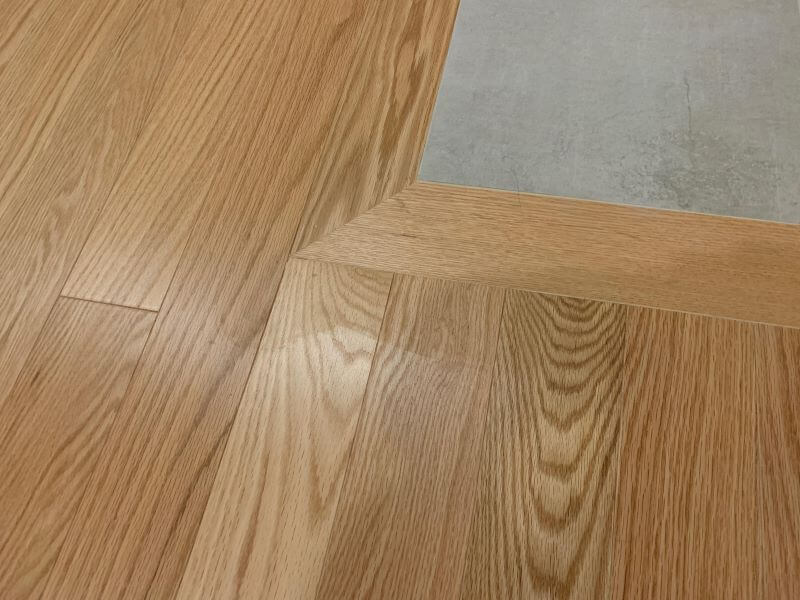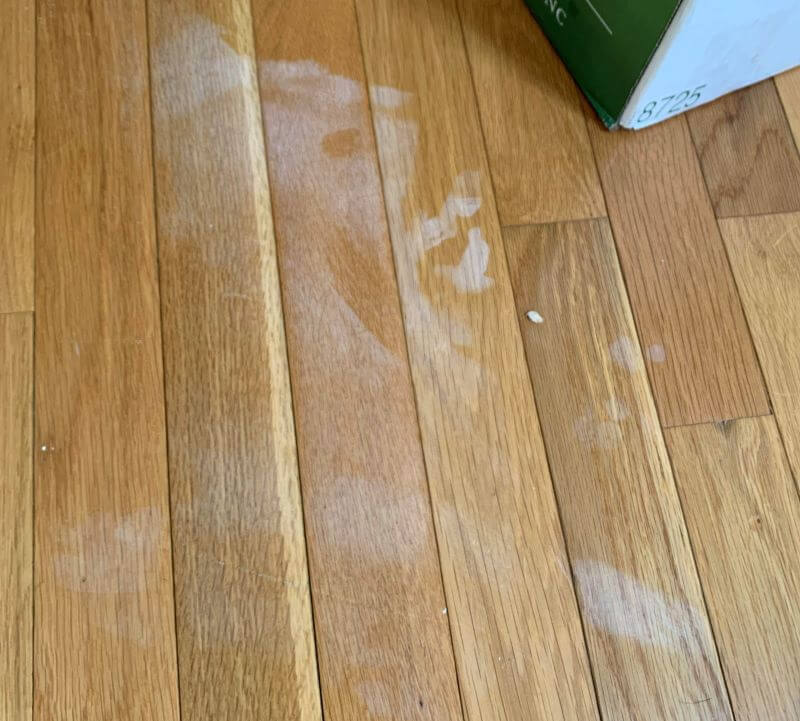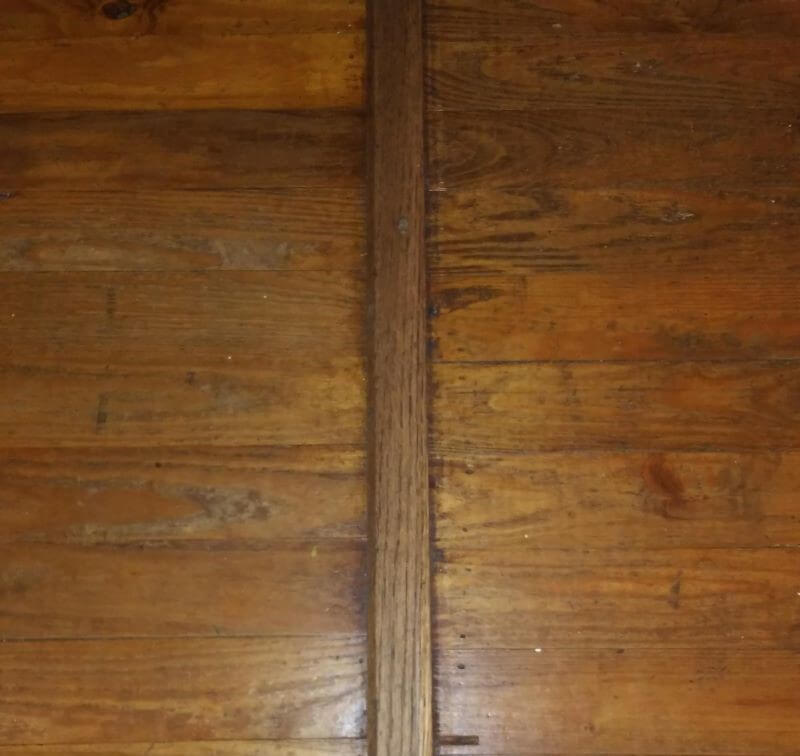Figuring out how to remove haze from a hardwood floor can be frustrating. You might have applied various methods to return your wood floors to their former beauty.
Yet, each attempt seems more disappointing than the last one. You might be wondering if your hardwood floors are actually getting hazier despite your efforts or if it’s your imagination. Relax. You’re not losing it. Honest.
In this article, we’ll discuss the causes as well as what to do about the cloudy film on your hardwood floors.

Why Do Your Hardwood Floors Look Cloudy(Hazy)?
Knowing the cause of haze on your hardwood floor is half the battle won. So, let’s take a look at what the trouble could be:
1) Trapped Moisture
If you’ve noticed cloudiness after refinishing your wood floor, the likely cause is insufficient drying time between coats of varnish. To remove the white haze from your hardwood floor, first, try doing nothing. It might be possible for the moisture to leave on its own in a couple of days.
2) Wax Build-up
Very few hardwood floors are finished with a penetrating seal anymore, but if your floors are sealed with wax, occasional waxing is called for. Frequent waxing is not.
Also, today, most hardwood floors are coated with a polyurethane finish. The coating doesn’t need to be waxed at all. Putting wax over a polyurethane finish will invariably leave a film on your hardwood floor.
Learn: How To Remove Wax Buildup From Wood Floors

3) Inappropriate Cleaning Solution
There are more floor cleaning solutions available on the market than ever. But not all floor cleaning solutions are good. Not all are intended for all hardwood floor finishes. It isn’t always easy to navigate a clear path to the solution that’s best for your hardwood floor. Cleaning a urethane-coated floor with a solution not intended for such can cause trouble. So be sure to read labels.
4) Inappropriate Application Of Cleaning Solution
Applying too much cleaning solution can result in hardwood floors that have an uneven, white, cloudy film over them. Here again, strong emphasis is placed on the importance of labels. Follow application and/or dilution instructions to the letter. More isn’t necessarily better. A stronger solution isn’t necessarily better either. “More” and “stronger” aren’t always as easy to remove.
5) Infrequent Change Of Cleaning Pad
To do its job effectively, a cleaning pad must be clean. Frequent rinsing and wringing will keep the pad clean, but the less you need to touch a dirty mop pad, the better. With plenty of clean mop pads on hand, there’s less chance of dragging dirt and germs across all the hardwood floors in your house. There’s also less handling of dirty pads.
Because most mop pads are machine washable, you can simply toss the used and dirty pads into the washing machine when you’re done cleaning your hardwood floors. Frequent changing of mop pads is better than frequent rinsing of the same mop pad. Better for your floors and better for you and your family.
6) Tap Water, Rain, And Snow
If it comes from nature, it’s good. Right? Mmmm… not necessarily. Your hardwood floors also come from nature. Trees need water to grow, of course. But your floors’ polyurethane coating doesn’t and hopefully, your floors have stopped growing. Your hardwood floors and the polyurethane that coats them should have limited contact with water.
This should especially be the case with hard water. Hard water, rain, and snow can do to the surface of a floor what they can do to a shower door. They leave an ugly white film that’s made from hard water deposits. Use water to damp mop only. Then use a flip-style mop and the chenille side of the mop pad to wipe the surface completely dry. Keep plenty of extra mop pads on hand.
If hard water constantly reminds you of its presence, use a neutral pH solution to clean your floors.
Snow is particularly loaded with salt. This makes long winters even longer for hardwood floors where entry mats have inadequate bristles and poor absorption.
Popular Remedies For Getting Rid of Haze on Hardwood Floors
Here are a few of them:
1) Olive Oil Mayonnaise For Floor Blushing
Blushing is the term used when moisture is trapped between or under the layers of a hardwood floor’s finish. The popular remedy for this involves spreading olive oil mayonnaise over the cloudy areas of the floor.
This might seem a little whacky until you think about the science involved:
Because oil is heavier than water and the two don’t mix, the oil displaces the water. The water has nowhere to go but the surface where it’s met by the mayonnaise. High fives and bonding follow. Wherever one goes, the other goes.
Naturally, when the mayonnaise is removed, the water goes with it. Thus, no more blushing.
Here’s what you’ll need:
- 1 Jar of Olive Oil Mayonnaise
- 1 Rubber Spatula
- 1 Roll of Super Absorbent, Lint Free Paper Towels
- Flip Style Mop
- Two-sided Microfiber Mop Pad
Directions:
- Remove area rugs, furniture, and all other items from the entire room.
- Dust and damp mop.
- With the rubber spatula, scoop out enough mayonnaise to spread a layer over the affected area of your wood floor. About ⅛” to ¼” thick.
- Let the mayonnaise sit without drying, for one hour.
- Use the paper towels to wipe the mayonnaise from the floor. Depending on the size of the affected area, you might need a generous amount of these.
- Working in small sections, damp mop with the short-napped side of the mop pad to remove any oily residue.
- Use the long-napped side of the mop pad to wipe the floor dry.
- If some haze remains, repeat the process. You’ll need to use your judgment or best guess to increase or decrease the time between application and removal of the mayonnaise.
2) Vinegar To Remove Haze Caused By Hard Water, Cleaning Solutions, Or Floor Wax
Vinegar is another popular remedy for hazy hardwood floors. Most wood flooring manufacturers and professionals advise against it. We’re no exception.
Yet, there’s an increasingly popular belief about certain household products. Accordingly, if a solution is acidic, but diluted with water, it will clean your floor and do it safely. So, it’s the solution to use.
Following that logic, diluted battery acid will also clean a wood floor without damaging it. But no one seems to consider using it to clean a floor. Maybe this is because battery acid isn’t a household product.
Whatever the logic used, people seem to be unshakeably convinced that white vinegar can do no harm. Irreversible staining of raw wood and clouding on coated wood floors aside, this may be true.
Still, this is as good a place as any to offer advice to first try new solutions in an inconspicuous area of your floor.
Here’s what you’ll need:
Directions:
- Remove rugs, furniture, and other objects from the workspace.
- Thoroughly dust the floor.
- Mix all ingredients into the bucket.
- Dip the mop in the bucket and wring it out until it’s almost dry.
- Move the mop in an ‘S’ pattern across the hazy area of your hardwood floor.
- To be sure the floor doesn’t dry on its own and leave streaks, dry the floor with a microfiber cloth as you go.
This method is also used to deep clean hardwood floors.
Now that we have the condiments out of the way…
Remedies For Removing Haze From Hardwood Floors That Work
Apart from removing the finish altogether, there are two solutions for removing the ugly white film. In the right measure and correctly applied, the haze will be removed while the wood and finish remain uncompromised using either of these two solutions. Both solutions also function as disinfectants.
1) 3% Hydrogen Peroxide
Hydrogen peroxide is the quintessential cleaning solution. It cleans, disinfects, is odor-free, and very inexpensive to buy. The solution is almost invariably sold in dark brown containers. This is because hydrogen peroxide is sensitive to light. It also has a shelf life of about six months to a year.
Whether or not there’s haze on your hardwood floors, hydrogen peroxide will leave them clean, disinfected, and looking refreshed and restored. To use hydrogen peroxide to remove haze from your hardwood floor,
Here’s what you’ll need:
- 1 Bottle of 3% Hydrogen Peroxide
- 1 Clean Empty Spray Bottle.
- 1 Flip Style Mop
- Several Two-Sided Microfiber Mop Pads
Directions:
- Remove all rugs and furniture from the work area.
- Dust and damp mop the floor.
- Transfer the contents of the hydrogen peroxide bottle into the empty spray bottle.
- Working in 2’ x 2’ sections, spray the floor with the peroxide.
- Let the peroxide stand for several seconds without allowing it to dry.
- Use the wet side of the mop pad to work out the haze.
- Spray again.
- Use the chenille side of the mop pad to wipe the floor dry. You might need to put a very small bit of back into it.
- Change the microfiber mop pad frequently throughout the process until the floor is clean.
2) Ammonia Based Or Ammonia Free Window Cleaner
Follow the instructions for cleaning with hydrogen peroxide. Substitute peroxide with an ammonia-free window cleaner. If this doesn’t remove the haze, try substituting with a conventional ammonia-based window cleaner instead.
Once all the haze has been removed from your wood floors, be sure to clean the rugs and dust furniture before bringing them back into the room.

